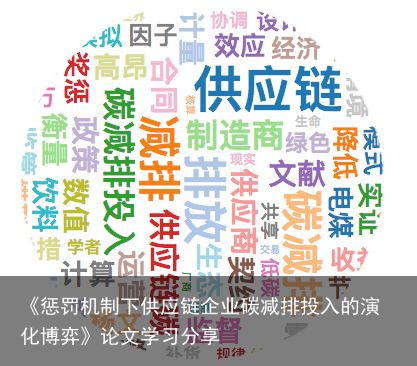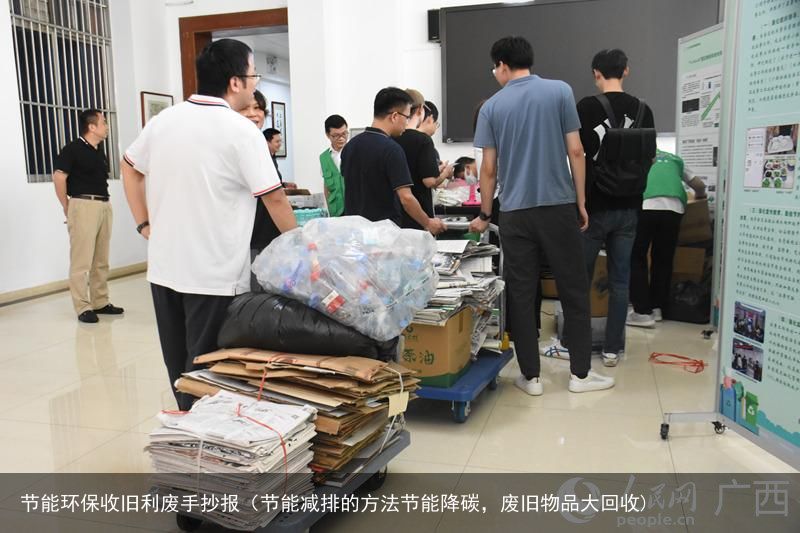《惩罚机制下供应链企业碳减排投入的演化博弈》论文学习分享
 论文赏析.m4a3:03来自LearningYard学苑
论文赏析.m4a3:03来自LearningYard学苑摘要
针对气候变暖下消费者愿意对低碳产品支付更高价格的情境,以及供应链碳减排投入的外部正效应问题,考虑由上游企业的供应商与下游企业的制造商组成的二级供应链,论文研究了供应商与制造商的碳减排投入行为与策略。依据供应商与制造商采用不同的行为策略的支付矩阵,建立了供应商与制造商碳减排投入的演化博弈模型,并分析得到供应商与制造商减排投入行为的演化稳定策略。结果表明: 供应商与制造商的碳减排投入策略与双方碳减排投入收益比密切相关, 当双方碳减排投入收益比不断变化时,出现多种演化稳定均衡。针对在碳减排投入中供应商或制造商的“搭便车”行为问题,分析了契约与惩罚机制下的演化博弈结果。最后,给出了数值模拟, 验证了模型的有效性。
英语翻译:In view of the situation that consumers are willing to pay higher prices for low-carbon products under climate warming, and the external positive effects of carbon emission reduction inputs in the supply chain, consider the secondary supply composed of upstream companies’ suppliers and downstream companies’ manufacturers Chain, the paper studies the carbon emission reduction investment behavior and strategy of suppliers and manufacturers. Based on the payment matrix of different behavior strategies adopted by suppliers and manufacturers, an evolutionary game model of carbon emission reduction investment between suppliers and manufacturers is established, and the evolutionary stable strategy of emission reduction input behavior of suppliers and manufacturers is analyzed. The results show that the carbon emission reduction investment strategies of suppliers and manufacturers are closely related to the carbon emission reduction investment income ratio of both parties. When the carbon emission reduction input income ratio of the two parties continues to change, a variety of evolutionary stable equilibriums will appear. Aiming at the "free-riding" behavior of suppliers or manufacturers in carbon emission reduction inputs, the evolutionary game results under the contract and punishment mechanism are analyzed. Finally, a numerical simulation is given to verify the validity of the model.
学习笔记:作者引言的部分言简意赅,红色部分标明了一些词语自己不常使用的书面表达。
引言
近年来,全球气候变暖趋势进一步加剧,已逐渐成为国际社会高度关注的热点之一。发展低碳经济、节能减排已成为促进全球经济可持续发展的重大战略举措之一。在低碳背景下,各国政府都在讨论减少温室气体排放的解决方案。我国作为世界上最大的二氧化碳排放国,承诺到 2020 年单位国内生产总值( GDP) 二氧化碳排放比 2005年下降 40% ― 45% 。目前,企业的碳减排是由政府等相关部门监督管理,但是监管是需要成本,成本在一定条件下可能很高昂。此外,这种治理模式本质上来说还是属于外部治理,碳减排的根本解决方法是供应链上的节点企业进行一定的碳减排投入,尤其是供应链上游的供应商和处于核心位置的制造商。供应商的碳减排投入是保证制造商能否获得低碳原材料和降低原材料成本的基础,而制造商的碳减排投入影响最终产品的碳足迹、成本和市场的需求[1], 它反过来也影响到供应商的收益。因此,从企业内部治理因素的角度探寻供应链中企业的碳减排投入行为的决策方法尤为必要。
英语翻译:In recent years, the global warming trend has intensified, and it has gradually become one of the hotspots of great concern to the international community. The development of a low-carbon economy, energy conservation and emission reduction has become one of the major strategic measures to promote the sustainable development of the global economy. In the context of low carbon, governments around the world are discussing solutions to reduce greenhouse gas emissions. As the worlds largest carbon dioxide emitter, China has pledged to reduce carbon dioxide emissions per unit of gross domestic product (GDP) by 40%-45% by 2020 compared to 2005. At present, the carbon emission reduction of enterprises is supervised and managed by the government and other relevant departments, but supervision requires costs, and the cost may be very high under certain conditions. In addition, this governance model is essentially external governance. The fundamental solution for carbon emission reduction is that node companies in the supply chain make a certain amount of carbon emission reduction investment, especially for suppliers in the upstream of the supply chain and manufacturing at the core. Quotient. The carbon emission reduction input of suppliers is the basis to ensure that manufacturers can obtain low-carbon raw materials and reduce the cost of raw materials, while the carbon emission reduction input of manufacturers affects the carbon footprint, cost and market demand of the final product [1], which reflects It also affects the suppliers income. Therefore, it is particularly necessary to explore the decision-making method of the carbon emission reduction investment behavior of enterprises in the supply chain from the perspective of enterprise internal governance factors。
学习笔记:作者引言背景也是以最近颁布的政策开始,表明文章研究的意义,提示自己也应多搜集关于自己方向的最新的相关政策与新闻。并在引文部分就合理、恰当的的引用了相关文献。
目前,关于“碳排放”的研究层出不穷,有很多文献从经济学角度设计市场减少和允许碳交易、在环境经济学考察不同环境政策对经济的影响和企业层面的碳排放内涵、计量、核算以及国家政府层面的碳排放权交易与分配等方面[2 -5]。但是, 这些文献只注重直接碳排放忽略出现在供应链中不同企业之间相互作用的重要因素。于是,国内外已有学者开始从整条供应链上来关注碳排放问题, 这些研究集中在 5 个方面: 1) 关于供应链上碳排放测量和管理, 如 Braithwaite 和 Knivett[6]以 Time-to-Serve 供应链绘图技术提出了一种新的供应链碳足迹的计算方法, Cholette 和 Venkat[7]计算了食品和饮料供应链中运输和仓储活动的能源耗费和碳排放, Benjaafar 等[8] 等针对需求已知、具有多补货期的特定计划周期和考虑厂商如何决定补货以及补货多少的问题建立了严格排放限额模型、碳税模型、限额与交易模型以及碳抵消模型,Sundarakani 等[9] 分别从静态供应链和动态供应链方面应用拉格朗日和排队论建立了一个碳排放衡量模型, 姜庆国[10]分析了电煤供应链碳排放过程并提出了测度方法及指标; 2) 关于因素对供应链碳排放的影响, 如许舒婷[11] 分析了区域生态供应链中的信息共享对供应链碳排放的影响, 杨珺等[12] 基于系统动力学分析了强制排放和碳税两种碳排放政策对供应链碳排放的影响, McKinnon[13] 通过实证分析了承运人对海运供应链碳排放的影响; 3) 关于供应链碳排放评价问题, 如杨文佳[14]采用生命周期评价方法与投入产出分析方法相结合分析了供应链碳排放评价问题, Acquaye 等[15]建立了不同行业的供应链碳排放基准; 4) 关于碳减排对供应链网络与运营的影响,如 Elhedhl 和 Merrick[16] 分析了考虑减少碳排放下绿色供应链网络设计问题, 李昊和赵道致[17]分析了不同碳排放权交易的指标对供应链企业运营决策的影响, 高举红等[18] 分析了在考虑碳排放因子和成本因子下闭环供应链系统收益波动规律,郭成恒和丁雪峰[19] 分析了考虑碳排放差异的闭环供应链奖惩机制与减排策略,Tseng 和 Hung[20]考虑碳排放引起的运作成本和社会成本建立可持续供应链管理战略决策模型; 5) 低碳供应链上不同利益 主 体 间 运 作 协 调 与 优 化 等,如赵道致等[21 - 22]研究了由单个制造商和单个零售商组成的供应链的协调机制设计问题以及制造商向具有公平偏好的零售商提供不同契约的供应链协调问题,鲁力和陈旭[23]研究了不同碳排放政策下基于回购合同的供应链协调问题。
英语翻译:At present, there is an endless stream of research on "carbon emissions". There are many documents designing market reduction and allowing carbon trading from an economic perspective, examining the impact of different environmental policies on the economy in environmental economics, and the connotation, measurement, accounting, and accounting of carbon emissions at the corporate level. The carbon emission rights trading and distribution at the national government level [2-5]. However, these documents only focus on direct carbon emissions and ignore the important factors that appear in the interaction between different companies in the supply chain. Therefore, scholars at home and abroad have begun to pay attention to carbon emissions from the entire supply chain. These studies focus on five aspects: 1) Regarding carbon emissions measurement and management in the supply chain, such as Braithwaite and Knivett [6] with Time-to -Serve supply chain mapping technology proposed a new method for calculating the carbon footprint of the supply chain. Cholette and Venkat [7] calculated the energy consumption and carbon emissions of transportation and storage activities in the food and beverage supply chain, Benjaafar et al. [8] For the specific planning cycle with known demand, multiple replenishment periods, and considering how manufacturers decide to replenish and how much replenishment, a strict emission limit model, a carbon tax model, a limit and transaction model, and a carbon offset model have been established. Sundarakani, etc. [9] Applying Lagrangian and queuing theory to establish a carbon emission measurement model from the static and dynamic supply chains, Jiang Qingguo [10] analyzed the carbon emission process of the power coal supply chain and proposed measurement methods and indicators; 2) Regarding the influence of factors on the carbon emissions of the supply chain, such as Xu Shuting [11] analyzed the impact of information sharing in the regional ecological supply chain on the carbon emissions of the supply chain, Yang Jun et al. [12] analyzed the compulsory emissions and carbon emissions based on system dynamics. The impact of two carbon tax policies on supply chain carbon emissions, McKinnon [13] used empirical analysis of the carrier’s impact on the carbon emissions of the maritime supply chain; 3) Regarding supply chain carbon emissions evaluation issues, such as Yang Wenjia [14] The life cycle assessment method and the input-output analysis method are combined to analyze the supply chain carbon emission evaluation issues. Acquaye et al. [15] established supply chain carbon emission benchmarks for different industries; 4) Regarding the impact of carbon emission reduction on supply chain networks and operations For example, Elhedhl and Merrick [16] analyzed the problem of green supply chain network design considering the reduction of carbon emissions. Li Hao and Zhao Daozhi [17] analyzed the impact of different carbon emission trading indicators on the operation and decision-making of supply chain enterprises. [18] analyzed the volatility of the closed-loop supply chain system revenue under the consideration of carbon emission factors and cost factors. Guo Chengheng and Ding Xuefeng [19] analyzed the closed-loop supply chain reward and punishment mechanism and emission reduction strategies considering carbon emission differences, Tseng and Hung[ 20] Consider the operating costs and social costs caused by carbon emissions to establish a strategic decision-making model for sustainable supply chain management; 5) Coordination and optimization of operations among different stakeholders in the low-carbon supply chain, such as Zhao Daozhi et al. [21-22] The design of the coordination mechanism for a supply chain composed of a single manufacturer and a single retailer, and the supply chain coordination problem of a manufacturer providing different contracts to retailers with fair preferences, Lu Li and Chen Xu [23] studied under different carbon emission policies. Supply chain coordination issues based on repurchase contracts.
学习笔记:文献综述一开始作者就对关于碳排放的研究有一个总体的概括,用词精准和学术化,分为经济学和环境经济学、企业和国家不同的层面来概述。后面关于整条供应链的碳排放问题,也是清晰的分为了5个点。所以感觉自己如果想对研究的问题更好的写出文献综述,应该是对近年来所有的相关文献都有一个总结和分析。作者的每一篇文献综述的总结都很干净简介,几乎都是一句话概括重点。
近些年来,随着博弈论的发展,已有一些学者运用博弈论方法对供应链碳排放问题展开研究,取得了一些重要研究成果[16 - 30]。但是, 现有研究仍然存在不足, 比如, 现有研究都没有考虑供应链碳减排投入具有外部正效应, 而这恰恰就为供应链上各节点企业提供了一个“搭便车”的动机. 正因为供应链碳减排投入外部正效应的存在, 将会极大地影响到供应链中各节点企业的决策, 进而使得各节点企业的行为演化出现新的特点和规律. 不过, 目前鲜有文献以供应链中的供应商和制造商为主体, 运用演化博弈论来分析其碳减排投入行为问题。本文将在演化博弈的基础上, 研究现实中供应商与制造商的碳减排投入问题, 通过引入碳减排投入收益比, 分析现实中供应商和制造商行为的策略选择。
英语翻译:In recent years, with the development of game theory, some scholars have used game theory methods to conduct research on carbon emissions in the supply chain, and have achieved some important research results [16-30]. However, the existing research still has shortcomings. For example, none of the existing research considers that the supply chain carbon emission reduction investment has an external positive effect, and this precisely provides a "free-riding" motivation for all nodes in the supply chain. Precisely because of the existence of positive external effects of carbon emission reduction inputs in the supply chain, it will greatly affect the decision-making of each node enterprise in the supply chain, and thus make the behavior evolution of each node enterprise appear new characteristics and laws. However, there is currently little literature that focuses on suppliers and manufacturers in the supply chain and uses evolutionary game theory to analyze their carbon emission reduction investment behavior. Based on the evolutionary game, this paper will study the actual carbon emission reduction input of suppliers and manufacturers, and analyze the actual strategic choices of suppliers and manufacturers behavior by introducing the ratio of carbon emission reduction input to income.
学习笔记:关于供应链的碳排放问题的博弈论研究,作者认为是不足的,对这些研究成果一笔带过。重点突出在考虑供应链碳减排投入具有外部正效应对供应链各节点企业的决策的影响。自然地引入到了自己研究的问题上。
参考资料:谷歌翻译、《惩罚机制下供应链企业碳减排投入的演化博弈》
本文由LearningYard学苑原创,如有侵权,请联系删除。





